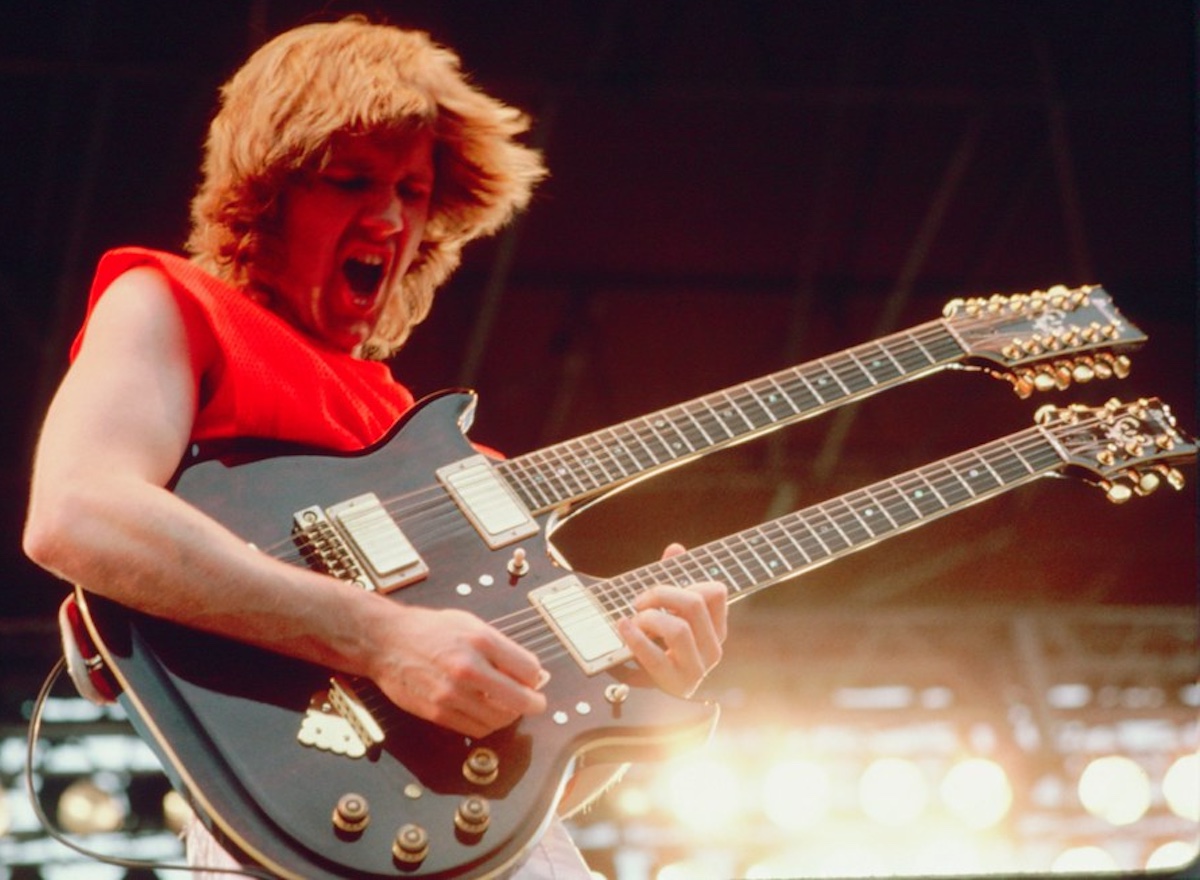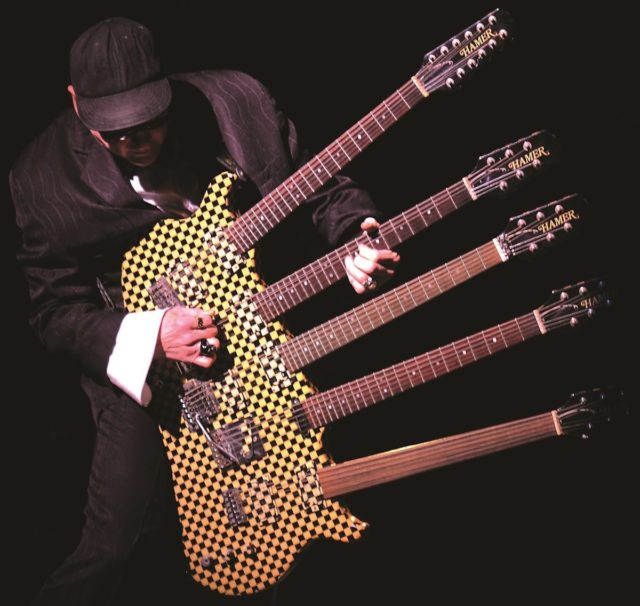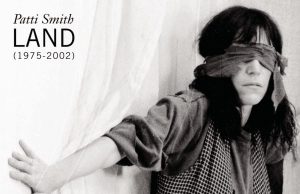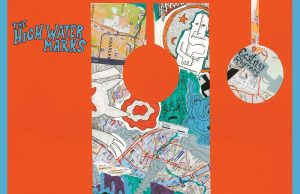 Someone should bring back the term “necking.” Nobody ever uses that anymore. I think it may have been a late-’70s/early-’80s thing. I’m not entirely sure, but I always assumed it meant “the act of making out, dominated by extraordinarily long periods of French kissing.” If I wrote a dictionary, that would be the first definition. The second would be “the practice of employing a multi-necked stringed instrument for the purpose of kickin’ it live.”
Someone should bring back the term “necking.” Nobody ever uses that anymore. I think it may have been a late-’70s/early-’80s thing. I’m not entirely sure, but I always assumed it meant “the act of making out, dominated by extraordinarily long periods of French kissing.” If I wrote a dictionary, that would be the first definition. The second would be “the practice of employing a multi-necked stringed instrument for the purpose of kickin’ it live.”
This also appears to be a hallmark of a bygone era, which surprises me. For starters, double-neck guitars are hella retro, and that’s always cool. Aesthetically, they’re conspicuous and awkward, which is something I always thought the hipsters constantly aimed for, with their uncomfortable hats, too-short pants and satchels. But, on a purely musical level, multi-neck instruments became popular in the ’70s so prog rock bands could more closely emulate the music from their records in a live setting when they’re without the luxury of overdubs.
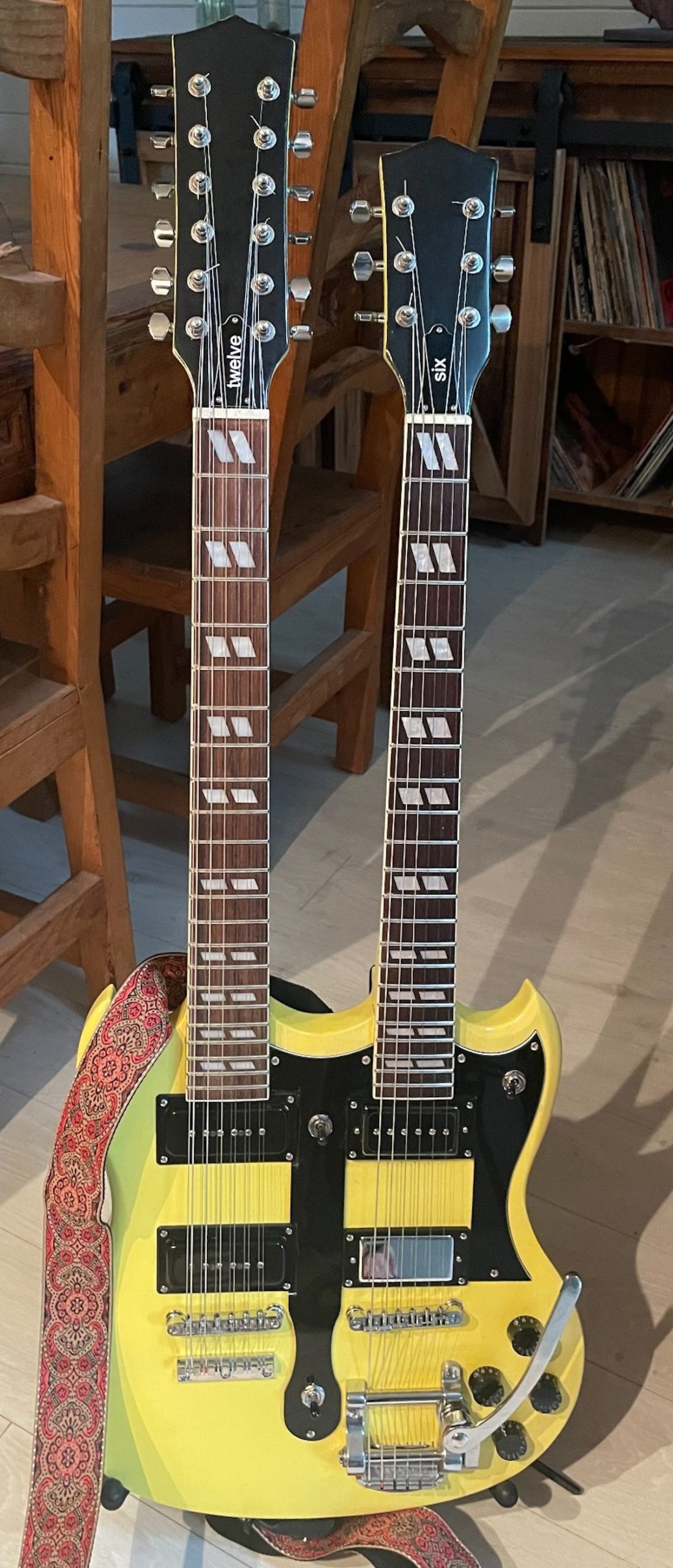 During the pandemic, my buddy Rob Bennett from The Bushpilots built his own from a kit he ordered online. Having already successfully made his own Thunderbird bass copy the previous year, this time he made a gorgeous copy of a double-neck SG.
During the pandemic, my buddy Rob Bennett from The Bushpilots built his own from a kit he ordered online. Having already successfully made his own Thunderbird bass copy the previous year, this time he made a gorgeous copy of a double-neck SG.
These days, with so many indie musicians — like myself — who construct multi-track songs at home alone, I’d have thought these spine-bending rock ’n’ roll multi-tools would be all the rage. They almost beg for one of those infomercials that begin with a hapless individual dropping, staining, breaking or flooding things. In this case, I imagine a musician — standing in front of a mic, acoustic guitar on one of those walk-up-and-play-it stands, with a harmonica around their neck, Strat slung over the shoulder and a Micro Korg and laptop plugged into a power bar and balanced precariously on a stand made for plants: “How many times has this happened to you?” (Whoopsie doo music) “Oh, Mr. Speedwagon — don’t you know there’s an easier way? — Introducing, THE DOUBLE NECK!!”
While I’m not sure an electric/acoustic/keytar exists, there have been plenty of notable and even custom combos created over the years. Six and 12-string guitar combos and guitar-bass combos mostly — but I thought we’d examine some of the famous or notable multi-neck monstrosities of popular music, starting with the ones I found right in my own record collection.
We’ll start with the prog rockers. Mike Rutherford was both the bassist and guitarist in Genesis — even back in the day when guitarist Steve Hackett was in the band. For Rutherford to fulfil his duties on stage — without constantly switching instruments — he first started actually duct-taping a Rickenbacker 360 12-string guitar to his Rickenbacker 4001 bass. Expensive, but not terribly professional-looking. So he hired a luthier to permanently meld the two instruments — or two similar instruments. He’s had several double necks since then, including another Rickenbacker with a 12-string on top and a six-string bass on the bottom, similar to a Fender bass-6. He may be best-known for his Shergold custom 12-string guitar/four-string bass which could be taken apart and used as two different guitars. There was also a graphite headless bass/12 string and a specially-made one which featured a Gibson 12-string on top and a Yamaha bass on the bottom.
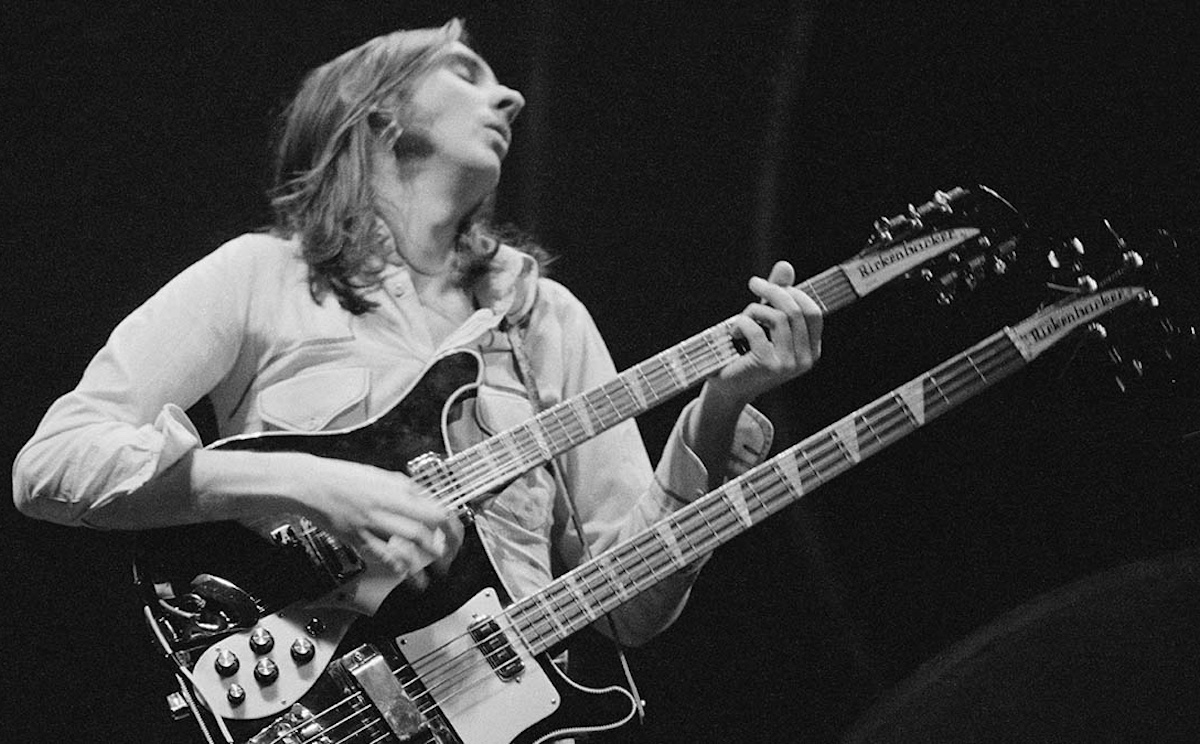
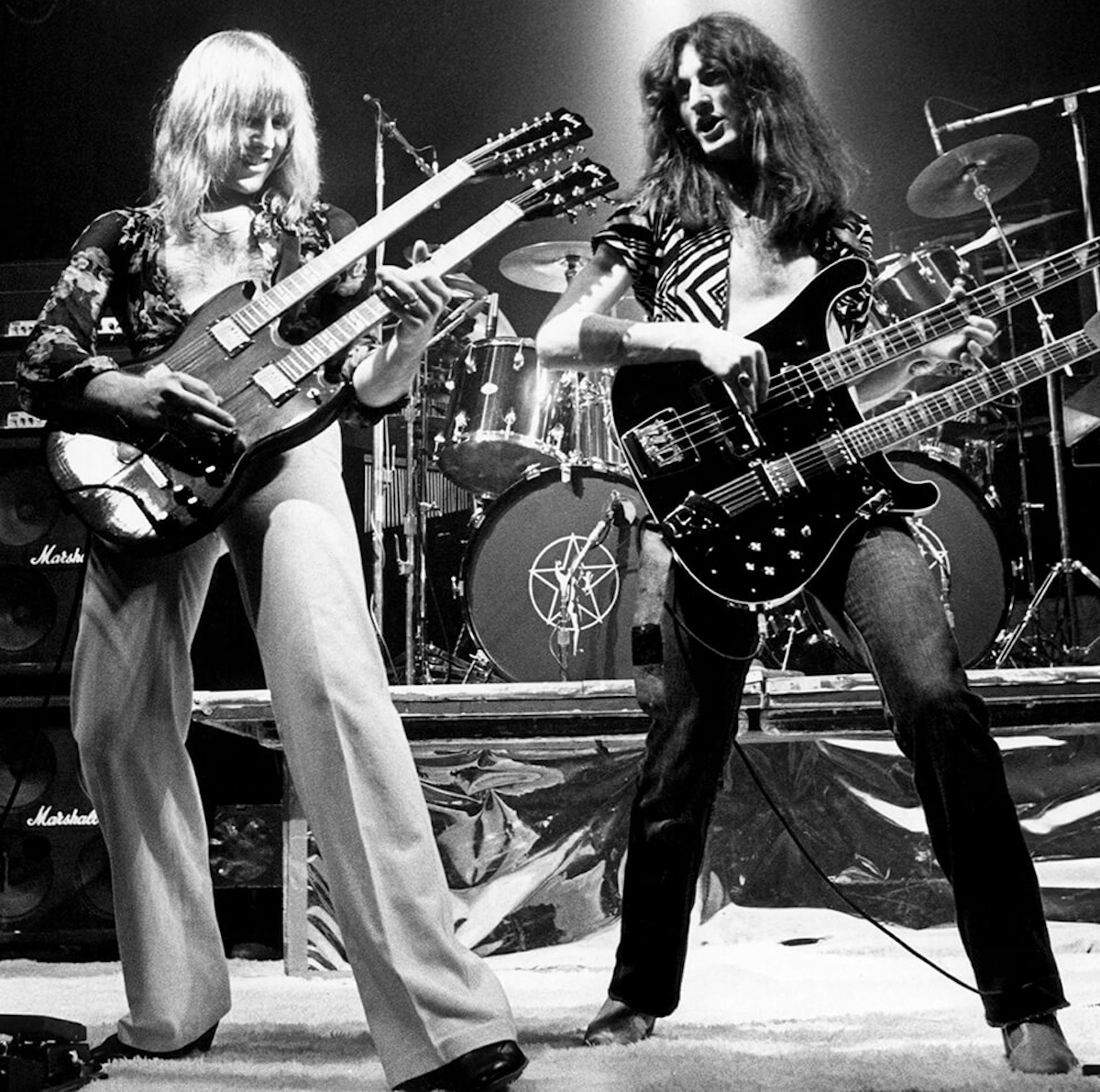
Both Geddy Lee and Alex Lifeson of Rush occasionally used double-neck instruments. Lee employed a Rickenbacker 4080, which is a 480 6-string guitar underneath a 4001 four-string bass. Seems to me the main use for this was for live performances of Xanadu. Lifeson had a Gibson EDS-1275, which he also used for Xanadu, along with A Passage To Bangkok. The EDS-1275 is rather iconic — a 12-string on top and a six-string on the bottom in a body style similar to a Gibson SG. This is the type of guitar my buddy Rob was trying to replicate. More famously, however, it is the type of guitar Jimmy Page used in Led Zeppelin for live performances of Stairway To Heaven. When Page decided this was the guitar he needed, Gibson had stopped making them. So, he had the company custom build him one. Page made it so famous that Gibson put them back into production — which they still are today, for $8K US. You can get an Epiphone version for around $1,500 CAD.
Among those who bought one after Page was Don Felder of Eagles, who used it on Hotel California. Tommy Shaw of Styx got one, but his was actually two 12-string necks. Pete Townshend used one briefly in 1967, but Steve Howe of Yes used one much more frequently — particularly during performances of Starship Trooper. Howe also used a Gibson EMS-1235, which has a body style similar to a Les Paul rather than an SG — except it has a mandolin on top and a six-string guitar on the bottom. Canadian one-hit wonder Jerry Doucette is also pictured with a white EDS-1275 on the sleeve of Mama Let Him Play.
Session star Grady Martin (Elvis, Willie Nelson) played a mandolin/guitar combo made by Bigsby. Cooler though, was the Mosrite double-neck of Joe Maphis. It featured a six string on the bottom and a 12 on top — with a shorter neck. Mosrite guitars are probably best known as the axe of choice for The Ventures, The Ramones and The B-52’s.
The late Denny Laine played both guitar and bass with Wings in the ’70s. But his double-neck was a 12 and six-string guitar made by Ibanez. He used it loads — but for sure on Band On The Run. It’s an Ibanez 2470. Gerry Beckley from America had one too. Triumph’s Rik Emmett had an Ibanez and currently owns a Gibson EDS-1275. The Gibson was one of two double-neck guitars used by John McLaughlin of Mahavishnu Orchestra — the other one was a custom Rex Bogue.
If you’re a Spinal Tap fan like me, you no doubt have noticed that guitarists David St. Hubbins, Nigel Tufnel and bassist Derek Smalls all play bass on the track Big Bottom. Smalls, however, rocks a double-neck. It’s a BC Rich and is ridiculously rare and expensive. I found one on the used-gear sales site Reverb.com for $13K CAD.
While we’re on the subject of comedy, we can examine some of the more ludicrous multi-neck instruments out there. I should first mention Nitro guitarist Michael Batio, who co-developed a V-shaped double-neck guitar made by Dean and a Gibson quad guitar. The four-necked instrument has two seven-string necks and two six-string necks. Batio is also well-known for developing two multi-neck guitars types. The Double-Guitar is a V-shaped double-neck, the most recognizable of which is his USA Dean Mach VII.
But we really only need to look at Steve Vai (David Lee Roth, Frank Zappa) and Cheap Trick’s Rick Nielsen. Vai has a vast array of bonkers guitars — all inspired by Page and his famous Gibson. There’s a heart-shaped guitar with three necks and another he calls The Hydra. He was inspired to build it after watching Mad Max Fury Road. There’s this crazy-looking metal guitarist dude banging out riffs on the front of a moving truck. The guitar even shot flames. Vai dug it, big time. He first made a prototype called The Hyena, and then eventually his Hydra, which features a three-quarter size bass neck with the top two strings fretless, a 7-string guitar, a 12-string with half of it fretless, 13 harp strings and a guitar synthesizer.
Nielsen first conceived the idea of a five-necked guitar when he sketched it out on some scrap lined paper in the late ’70s. He brought the idea to Hamer guitars, who were unable to build it to his specs due to size and weight. Originally, Nielsen wanted the guitar to be circular so he could spin it. That got scrapped in favour of a design which melded together the bodies of five Hamer Special guitars. But it does have all the necks he wanted — a 12-string neck, a six-string neck, a six-string neck with Vibrola tailpiece, another six-string neck, and six-string fretless neck.
They’re all right — they just seem a little weird.
• • •
Area Resident is an Ottawa-based journalist, recording artist, music collector and re-seller. Hear (and buy) his music on Bandcamp, email him HERE, follow him on Instagram and check him out on Discogs.
